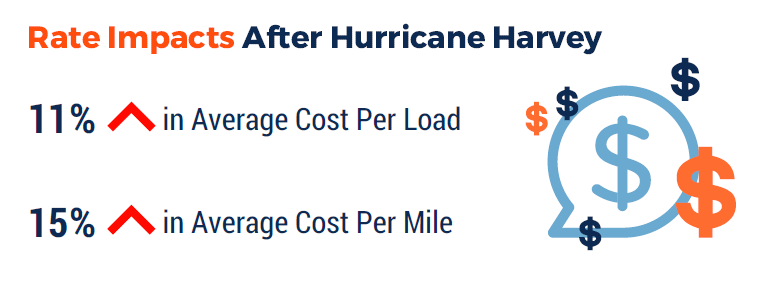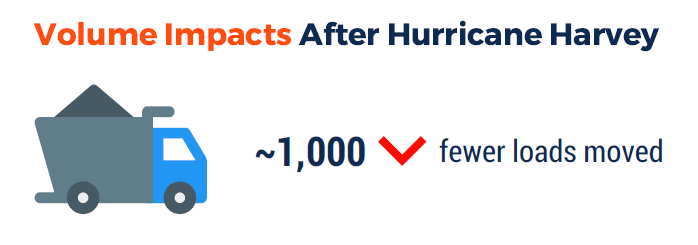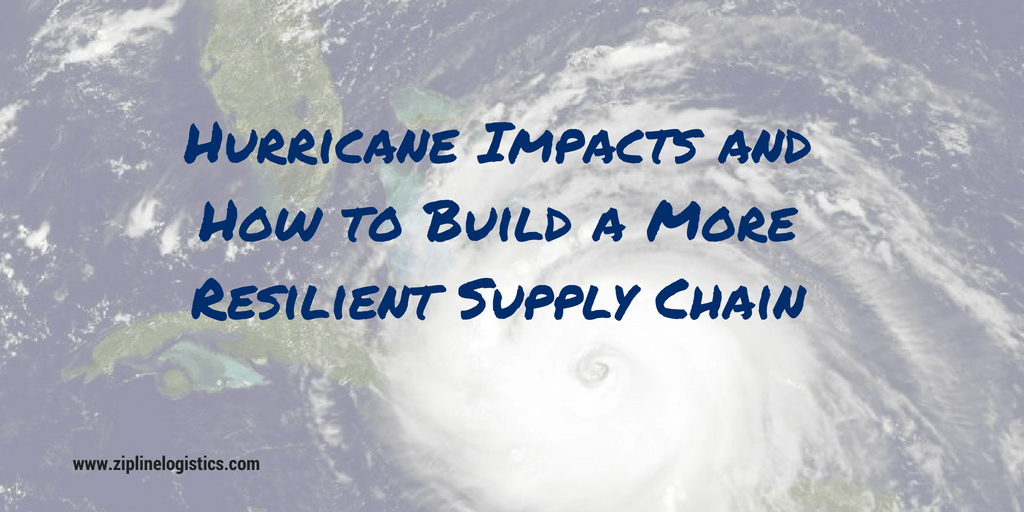Hurricanes have massive impacts on transportation capacity and spend. To better understand true cost and volume impacts, Zipline Logistics evaluated a sample of 33,000 shipments, comparing data prior to the 2017 Tropical Storm Harvey with data after the event.
Access the full report as a slideshow below, and keep reading this post for advice you can use to prepare your supply chain for the next tumultuous storm season (Note: the Atlantic Hurricane season runs from June 1 through the end of November.)
Hurricane Impacts on Transportation
We leveraged our KanoPI shipper intelligence platform to dig deep into hurricane impacts. Here’s what we found…
Market surcharges due to hurricane activity were the costliest of added fees in 2017 with a total cost of $673,000.91.
Data shows that the Average Cost Per Load after the 8/26 hurricane went up by $159.58, or 11% and that the Average Cost Per Mile increased by 15%.

915 fewer loads moved after the hurricane (date of 8/26/2017) when compared to previous four-month period. This tells us that people were holding on to shipments that would typically have moved into key areas like Florida, Texas, and surrounding states.
Looking specifically at Florida, there was an 8% drop in volume and 3.4% drop in spend. This shows that for shipments still moved, rates were higher.

Hurricanes brought prolonged delays. Looking at the data, we can see that average transit days went from 2.65 to 2.95, which is an increase of 10.17%.

Why were rates up, volumes down, and transit timelines extended after Hurricane Harvey?
High waters and flooded infrastructure caused cities like Houston, Texas to essentially shut down. Ports, roadways, rail lines, and airports were washed out, making it momentarily impossible to move products in and out of afflicted areas.
Even once roads, ports, and rails were back up and running, there was a rush of activity to recover from delays. Bottlenecks were common as everyone worked hard to catch up.
Fuel prices also increased, as damages to oil refineries on the Gulf Coast resulted in gas shortages.
Once able to enter cities, a sizable portion of capacity was diverted to deliver aid. This included movement of food, medical supplies, and building materials. It was noticeably more difficult to book trucks if moving products to and from nearby areas.
2018 Hurricane Season
NPR and researchers from Colorado State University report that the 2018 hurricane season will have slightly above-average activity, with 14 tropical storms predicted. Seven are expected to become hurricanes, which have a wind speed of at least 74 mph. Three of those seven are expected to be major hurricanes, Category 3 or higher, with winds reaching a minimum of 111 mph.
Natural disasters are occurring more regularly than years before. A typical year in the 1980s experienced on average 2.7 major disasters in the U.S, but in our current decade, each year has seen an average of 10.5 disasters. According to Jay L. Zagorsky, Economist and Research Scientist at The Ohio State University, the scale of this increase amounts to one additional billion-dollar disaster every four years.
Preparing Your Supply Chain for a Hurricane
Here is a listing of potential hurricane prep solutions. Encompassing a wide range of possibilities, we don’t recommend that businesses act on all the scenarios or solutions outlined, but identify those best suited for their unique supply chain needs.
However, we do suggest that all businesses work alongside their partners to understand the true and total cost impacts from tropical storms. If unaware of the cost and productivity impacts of storms on your business, you run the risk of being unprepared for the next inevitable disaster.
Insurance
Having proper insurance is likely the first and easiest step a business can take to protect itself from loss due to natural disasters. In addition to traditional property coverage, flood and business interruption policies should be considered.
- Flood Insurance: Water damage is not the same as wind or storm damage. Be sure you are covered for all of the above, or that your partners are if they are located in at-risk regions.
- Business Interruption Coverage: If your business has to close its doors or cease operations during storm cleanup, how much would you lose in sales and product? Calculating this value can be complicated and full of debate, but avoiding the crucial conversation could be detrimental.
Warehouse Network
If you have warehouses or production facilities located in cities known to be at-risk for tropical storms, you should be hyper-focused on hurricane prep and have plans in place for quick action.
The following metropolitan areas are most at risk during hurricane season:
- Miami, Tampa-St. Petersburg, Naples, and Jacksonville, Florida
- New York City, New York
- New Orleans, Louisiana
- Virginia Beach, Virginia
- Houston, Texas
If your volumes and reach allow, build your warehouse network to stretch beyond at-risk cities. This will help to not just keep a portion of your product free from storm threats (like flooding, being landlocked, or damage) but also enable you to fulfill orders from out-of-network warehouses when/if Southern or East Coast regions get hit and capacity disappears.
If your distribution footprint isn’t large enough to sustain multiple warehouse locations, consider temporary solutions. Having agreements in place with temporary storage providers or cross-dock facilities prior to a storm will make it easier for you when things get tough. You can quickly access your network and route product to safer ground.
If your network requires that your warehouse or production facilities are located in at-risk cities or in flood zones, ensure they too have prepped for storm potential.
- Is the building raised? Increasing height by 2 or 3 feet during construction can make all the difference
- Do they have flood barriers or gates?
- Can your product be stored on higher shelves?
- Do they have a disaster plan in place? This should include everything from communication protocols to tactical steps.
Drop Trailers
Similar to moving your product up to temporary storage facilities, if you have an asset-based partner, you may be able to execute on a temporary drop trailer initiative. This refers to loading up product and moving it to a yard that is out of harm’s way where the trucks can unhitch and wait out the storm. Have conversations far before storms hit so that you can ensure availability.
Leverage Rail
Moving product away from storm-afflicted regions is a reoccurring theme. Getting your product to safe areas either for storage or temporary utilization can help you keep business in motion. An option available to most companies is shipping goods via rail to locations further west or north. The added cost of transportation can easily outweigh the potential loss of sales or irrevocably damaged goods.
Backup Suppliers
If your main suppliers can no longer function in the aftermath of a hurricane, you run the risk of having your production lines shut down. That’s why it’s important to have backup partners who can step in and help keep things running during a storm.
You don’t want to be researching options or signing up as a new customer in the midst of a disaster. This only slows things down. It could be detrimental if something simple like a credit check or signature impedes your ability to make/move product during an emergency.
Backup Production
If your main production facilities are underwater or if area suppliers are unable to deliver for an extended period of time, you may want to consider temporarily transferring production to a secondary location. Can your other facilities or copackers take on additional orders?
This solution could circumvent the need to work with new suppliers, but would add strain to your existing locations. From the get-go, it should be understood that the move is temporary and that efforts to return to normal are in motion simultaneously.
Port Fluidity
Ports are often hit hardest during a hurricane due to their coastal locations. Establishing agreements with your logistics partners for real-time adjustments across shipping lines is key.
For example, if your shipment to the Port of Miami is in jeopardy you can divert the container to deliver at another port and keep your product in motion. Staying abreast of developing storm projections is imperative if looking to get ahead of port closures and congestion.
Change Up Fulfillment
Having positive relationships with your buyers can prove beneficial during a natural disaster. If you know a storm is on the horizon, ask your buyers if you can fulfill a larger order and ship more product ahead of the weather. Depending on their ability to house extra inventory, they may be willing to oblige. They too need product on shelves during a natural disaster. If not, they risk the chance of lost sales and angry customers.
Retail and Grocery
Recent supplier scorecard language clearly states that weather will no longer be a viable excuse for late deliveries. Vendors will still need to deliver food, beverage, and other consumables during a storm. This means everyone must plan ahead or face not just the loss of sales, but added fees and chargebacks.
Monitor weather patterns and communicate with your transportation partners about possible expedited shipments.
Plan Ahead for Added Costs
As mentioned earlier in this report, market surcharges due to hurricane activity were the costliest of added fees for Zipline Logistics customers in 2017. As capacity shifts to serve the needs of disaster relief and rebuilding, it gets harder to find trucks at historical costs.
Shippers should plan ahead for possible storm fees when budgeting transportation.
Additionally, shippers should have a process in place for how to approve any added costs. This will help your team move faster in the chaos of a storm and secure needed capacity when it’s tight. A delay caused by administrative hold-ups could mean an available truck gets booked by someone else.
Transparency with Technology
During times of crises, like a hurricane, having real-time access to tracking information, carriers, suppliers, and inventory counts will help you identify any storm-related issues that need to be addressed.
Ask your transportation and/or technology partners what visibility tools they provide.
How a 3PL Can Help
Unsure of which approach to take?
A 3PL partner can help you uncover what steps are most beneficial to your situation and goals. They will have a pulse on what’s happening in multiple regions and can direct you towards the best possible solution.
They can additionally source their network for recovery options and connect you with new, available capacity.
Have questions about prepping for hurricane season? Reach out to Zipline Logistics for aid.

